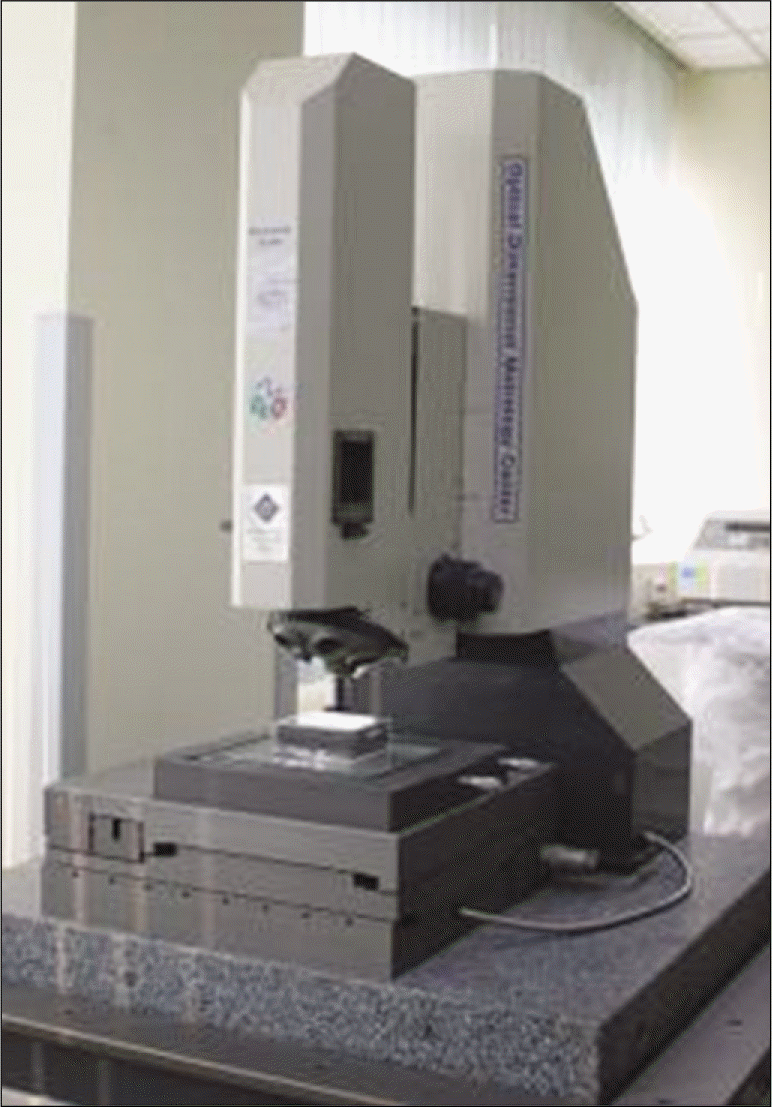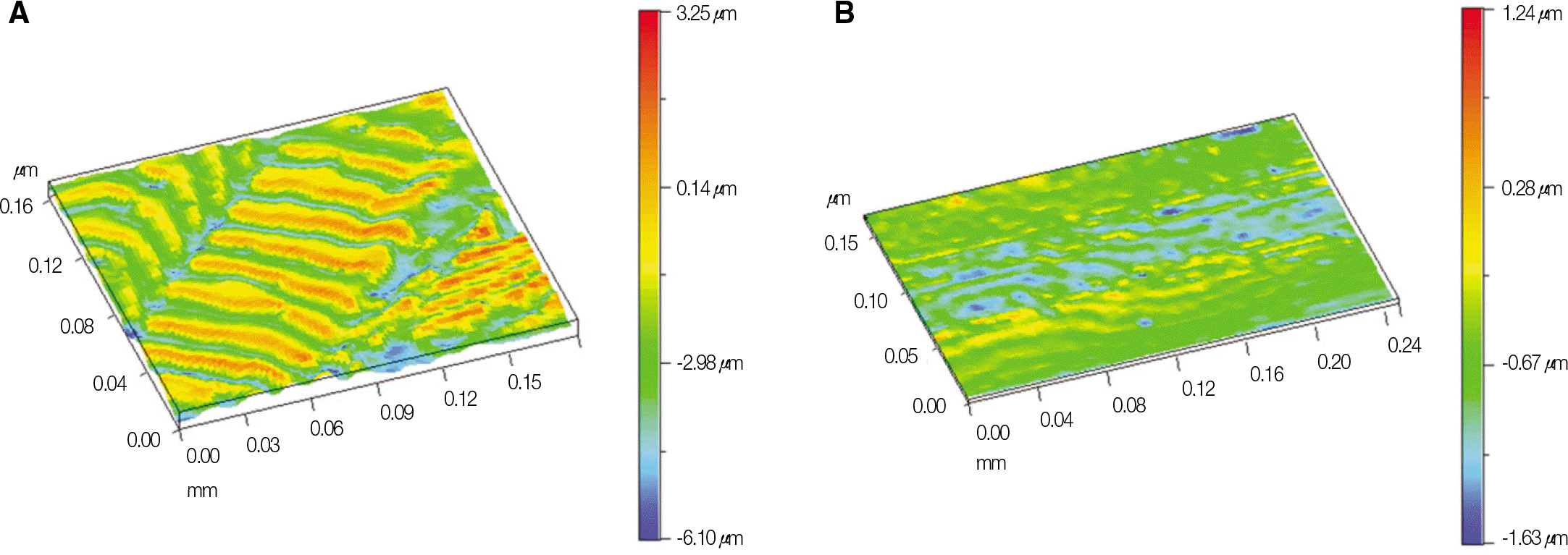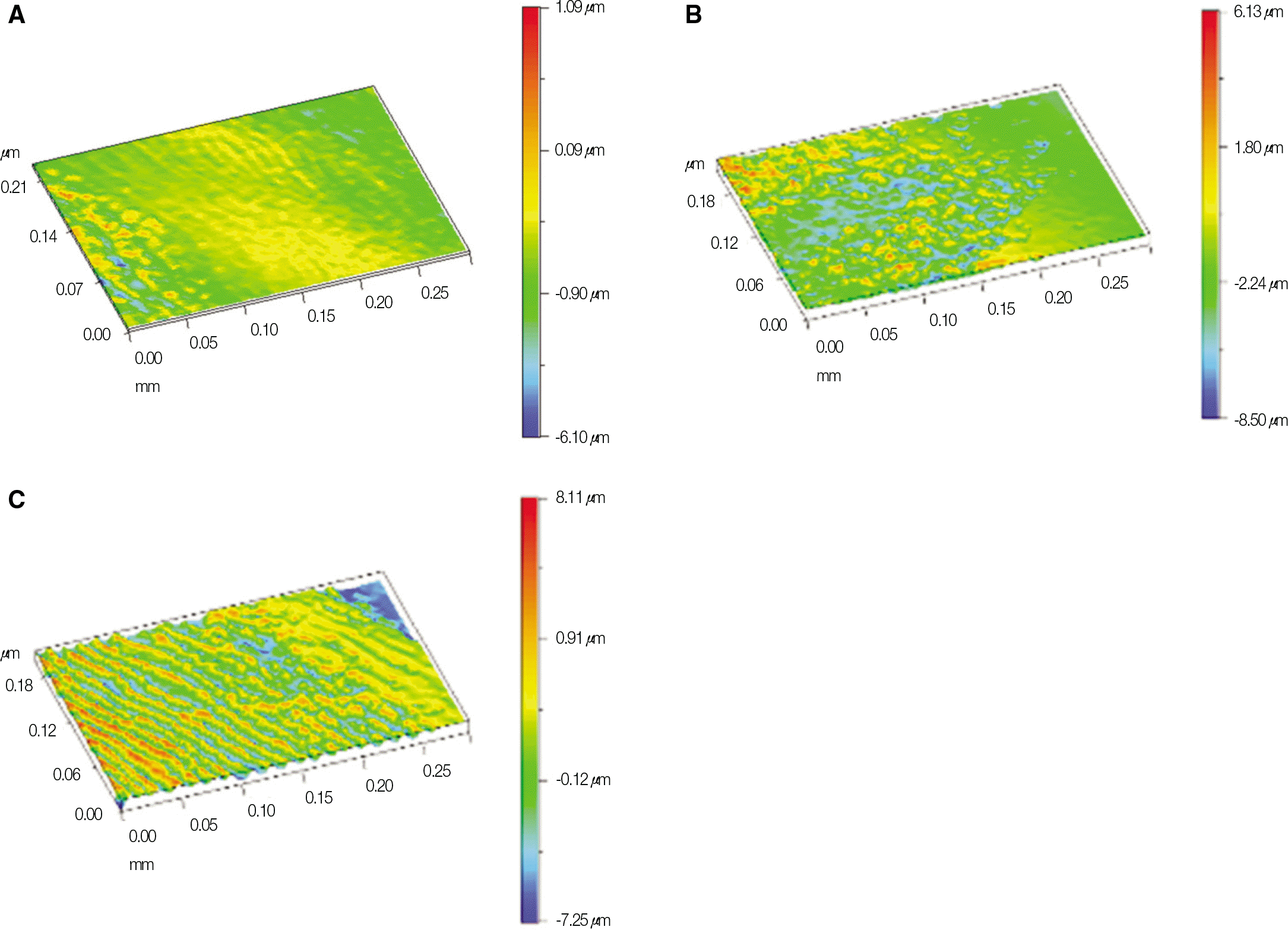Abstract
Purpose
This study evaluated the effect of polishing techniques on surface roughness of polymethyl methacrylate (PMMA), as well as the influence of light-cured surface glaze and subsequent brushing on surface roughness.
Materials and methods
A total of 60 PMMA specimens (10×10×5 mm) were made and then divided into 6 groups of 10 each according to the polymerization methods (under pressure or atmosphere) and the surface polishing methods (mechanical or chemical polishing) including 2 control groups. The mechanical polishing was performed with the carbide denture bur, rubber points and then pumice and lathe wheel. The chemical polishing was performed by applying a light-cured surface glaze (Plaquit®; Dreve-Dentamid GmbH). Accura 2000°, a non-contact, non-destructive, optical 3-dimensional surface analysis system, was used to measure the surface roughness (Ra) and 3-dimensional images were acquired. The surface roughness was again measured after ultrasonic tooth brushing in order to evaluate the influence of brushing on the surface roughness. The statistical analysis was performed with Mann-Whitney test and t-test using a 95% level of confidence.
Results
The chemically polished group showed a statistically lower mean surface roughness in comparison to the mechanically polished group (P = .0045) and the specimens polymerized under the atmospheric pressure presented a more significant difference (P = .0138). After brushing, all of the groups, except the mechanically polished group, presented rougher surfaces and showed no statistically significant differences between groups.
Go to : 
REFERENCES
2.De Rouck T., Collys K., Wyn I., Cosyn J. Instant provisionalization of immediate single-tooth implants is essential to optimize esthetic treatment outcome. Clin Oral Implants Res. 2009. 20:566–70.

3.Block MS., Mercante DE., Lirette D., Mohamed W., Ryser M., Castellon P. Prospective evaluation of immediate and delayed provisional single tooth restorations. J Oral Maxillofac Surg. 2009. 67:89–107.

4.Quirynen M., Marechal M., Busscher HJ., Weerkamp AH., Darius PL., van Steenberghe D. The influence of surface free energy and surface roughness on early plaque formation. An in vivo study in man. J Clin Periodontol. 1990. 17:138–44.

5.Taylor R., Maryan C., Verran J. Retention of oral microorganisms on cobalt-chromium alloy and dental acrylic resin with different surface finishes. J Prosthet Dent. 1998. 80:592–7.

6.Radford DR., Sweet SP., Challacombe SJ., Walter JD. Adherence of Candida albicans to denture-base materials with different surface finishes. J Dent. 1998. 26:577–83.

7.Quirynen M., Bollen CM. The influence of surface roughness and surface-free energy on supra- and subgingival plaque formation in man. A review of the literature. J Clin Periodontol. 1995. 22:1–14.
8.Bollen CM., Lambrechts P., Quirynen M. Comparison of surface roughness of oral hard materials to the threshold surface roughness for bacterial plaque retention: a review of the literature. Dent Mater. 1997. 13:258–69.
9.Herrgott AM., Ziemiecki TL., Dennison JB. An evaluation of different composite resin systems finished with various abrasives. J Am Dent Assoc. 1989. 119:729–32.

10.Lutz F., Phillips RW. A classification and evaluation of composite resin systems. J Prosthet Dent. 1983. 50:480–8.

11.McLundie AC., Murray FD. Comparison of methods used in finishing composite resin—a scanning electron microscope study. J Prosthet Dent. 1974. 31:163–71.

13.Loney RW., Moulding MB., Hacker CH., Ritsco RG. Finishing and polishing of a poly (fluoroalkoxyphosphazene) resilient denture liner. Int J Prosthodont. 1994. 7:362–7.
14.Maalhagh-Fard A., Wagner WC., Pink FE., Neme AM. Evaluation of surface finish and polish of eight provisional restorative materials using acrylic bur and abrasive disk with and without pumice. Oper Dent. 2003. 28:734–9.
15.de Gee AJ. Some aspects of vacuum mixing of composite resins and its effect on porosity. Quintessence Int Dent Dig. 1979. 10:69–74.
16.Finger W., Jorgensen KD. Porosity of composite filling materials. SSO Schweiz Monatsschr Zahnheilkd. 1977. 87:482–9.
17.Lambrechts P., Vanherle G. The use of glazing materials for finishing dental composite resin surfaces. J Oral Rehabil. 1982. 9:107–17.

18.Stoddard JW., Johnson GH. An evaluation of polishing agents for composite resins. J Prosthet Dent. 1991. 65:491–5.

19.Budtz-Jo ¨rgensen E., Kaaber S. Clinical effects of glazing denture acrylic resin bases using an ultraviolet curing method. Scand J Dent Res. 1986. 94:569–74.
20.Kuhar M., Funduk N. Effects of polishing techniques on the surface roughness of acrylic denture base resins. J Prosthet Dent. 2005. 93:76–85.

21.Neme AM., Wagner WC., Pink FE., Frazier KB. The effect of prophylactic polishing pastes and toothbrushing on the surface roughness of resin composite materials in vitro. Oper Dent. 2003. 28:808–15.
Go to : 
 | Fig. 1.Accura 2000å, a non-contact, non-destructive, optical 3-dimensional surface analysis system. |
 | Fig. 2.A: Surface analysis of mechanical polishing group before brushing, B: Surface analysis of chemical polishing (glazing) group before brushing. |
 | Fig. 3.Surface analysis of chemical polishing (glazing) of atmosphere polymerization group. A: Before brushing, B: After 3 minutes brushing, C: After 6 minutes brushing. |
 | Fig. 4.A: Surface roughness (Ra) of pressure polymerization groups, B: Surface roughness (Ra) of atmosphere polymerization groups. |
Table 1.
Groups according to the polymerized condition and polishing techniques
Table 2.
Means and SDs in parenthesis of surface roughness (Ra) (unit: μ m




 PDF
PDF ePub
ePub Citation
Citation Print
Print


 XML Download
XML Download